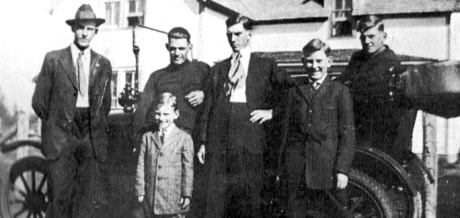More than 100 years ago, a likeable young doctor from the British Isles was looking for a location in this lush and peaceful prairie countryside to build a modern new mental hospital. On one of his leisurely tours from Edmonton to Calgary he decided to stop for a picnic lunch and a rest at a serene spot between Ponoka and Lacombe, and this was his initial choice, which he named Morningside after his palatial home back in the old country.
The Provincial Mental Hospital was later built two miles south of Ponoka but Morningside continued to thrive in those exciting early years of the sudden settlement of the central Alberta region. It was in this area in the 1890s the first crews of the C & E Railway Company (later Canadian Pacific Railway) would assemble in great numbers to cut and stack thousands of wooden ties in preparation for the laying of the main line steel track between Edmonton and Calgary. Remnants of this massive undertaking can still be seen in the tranquil setting of the popular J.J. Collett Natural Area just south of Morningside.
With the coming of the railroad, settlers moved into the district in great numbers, establishing their farms and ranches, while the small hamlet grew quickly to accommodate these new citizens, as well as the hundreds of men working on the railway. Morningside’s first store was built in 1901 by Mr. Fairfield, who would also serve as the district’s first post master, as well as encouraging the first school to relocate from Cink’s Saw Mill to the hall above his new store. The first church was built in 1901, the manse was added in 1910, and faithfully served the area until it burned to the ground in 1939. A new district school was built in 1915 by William Bowness and Sons for $1,400, and served many generations of children until closing in 1953.
In 1902 the growing population had to hold a vote on whether to build a hotel or a school — and the hotel won. The hamlet of Morningside literally grew by leaps and bounds in those early years and it took several district sawmills to keep up with the demand for lumber to erect businesses and residences. Services added included, The Broderson and Williams Boarding Houses, George Shilling’s Blacksmith Shop, the fancy hotels of Teeple/Dodds and Marshall, general stores owned by Webster and Detelloff, George McKee’s drugstore with Dr. Houston’s office, a creamery, and Jack Purnell’s fresh meat store. Grain elevators were also erected to store the bountiful harvests of area farmers.
Community gatherings and social events were many in the hamlet and districts, and were organized by ladies groups such as the Missionary Society, The Farm Women’s League, and local service clubs.
Some of the historical family names synonymous with the early success and growth of Morningside were: The Bowies, Halls, Beltons, Johnsons, Harts, Butlins, Beaches, Carters, Birneys, Flegals, Lewises, Sutherlands, Driggs, Grants, Quigleys and Sweets.
The Morningside district also garnered an early reputation for their great baseball teams. In 1913 keen games were played against the Ponoka lads on Saturday evenings on Paul Flegal’s land, always followed by weekend races, games, and picnics, as well as football games in the fall and hockey action on the nearby slough in the winter. By 1930 a very competitive league featured district baseball teams from Morningside, Milton, Rimbey, Lacombe, Clive and Joffrey, with the local team winning several Central Championships as well as the prestigious Lacombe tournament. Some of the members of those early Morningside baseball teams were: Charles Sweet, Jim McGarvey, Bill and Chant Brewer, Paul and Reg Beach, Bub Seifert, and the great Teeple, who later played with the Chicago White Sox. In later years, Wayne Sheppard helped to put together some very good local fastball and hockey teams.
Some of the milestones of Morningside
• Saturday night dances were popular above Houston’s store, with music provided by the violins of Cooney Morgan, his son Earl, and daughter Carry. It was discovered later that Conney’s violin had been bought from Herman Detteloff for $10 and after Morgan retired many years later it was found to be a priceless Stradivarius, and is now on display at the University of Washington Museum.
• The history books tell us that the Depression years were hard on Morningside, with many businesses declining, and several fires nearly wiped out the community!
• Then there was the infamous Quigley murder mystery, as told by George Grant in 1920. While out riding along Wolf Creek looking for strays, Paul Flegal claimed to have found a recently dug grave containing the body of a man. The RNW Mounted Police of Ponoka quickly responded and identified the body of Mr. Quigley, and reported that it looked like he had been hit on the head with a ball peen hammer, but no weapon was found. A lengthy trial followed with the famous Paddy Nolen defending Mrs. Quigley, but the hired man later confessed in a letter, and was sentenced to seven years.
The hammer was found years later, claimed by Aloisious Slepitka, and this spot, now located on the prestigious Wolf Creek Golf Resort has since been known as ‘Dead Man’s Crossing.’
Morningside may not be quite as ‘bustling’ as it was more than a century ago, but it will always be a neat and friendly hamlet, where many folks meet at the general store when shopping for groceries and gas, or at the community hall for special occasions.
Residents of Morningside have a colourful history and were a huge influence in the early development of this area, with credit going to the many generations of pioneer families for their ongoing dedication and keen spirit to achieve success while working and playing together.
